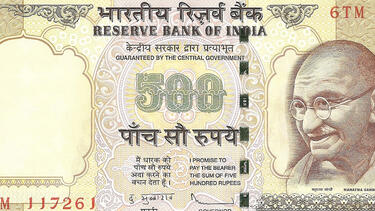What Are the Consequences of India’s Currency Reform?
In November, in an effort to fight corruption, India withdrew its two largest paper money denominations from circulation. Yale SOM’s Shyam Sunder looks at some possible effects of the change.

The 500-rupee banknote in the Mahatma Gandhi Series was demonetized on November 8, 2016.
This commentary is an updated version of an article originally posted on November 29.
On November 8, India’s government announced that it would ban existing 500- and 1000-rupee notes, the country’s two largest denominations. The aim is to undercut counterfeiters and combat the corruption and crime that rely on paper money. But most ordinary Indians keep their savings in paper currency as well. Since the announcement, they have rushed to convert their holdings into new denominations, with long lines and shortages at banks and ATMs. Others may simply give up their savings to avoid paying taxes. Businesses dependent on cash are expected to suffer, and some observers say that demonetization, as it is called, could even spark a recession. Yale SOM’s Shyam Sunder sketches what he sees as some of the effects this move is likely to have on the Indian economy.
The immediate consequences of the demonetization of 500- and 1,000-rupee notes and their replacement by new 500- and 2,000-rupee versions have been widely discussed. This change has less obvious intermediate and long term consequences—policy interventions set off many chain reactions which are difficult to forecast—but here is an attempt to do that.
The number of bank accounts, their balances, and the number of transactions will rise sharply. A fraction of the new bank accounts will belong to the people who had no accounts in the past, or had dormant accounts with few transactions. This heretofore unbanked population will become more aware of their financial opportunities and try to become more literate and numerate to protect their wealth and interests.
Numeracy and literacy—financial and general—will not rise overnight and thus will create opportunities for unscrupulous employers, bankers and others to exploit people. The banking industry will find it necessary to educate its new customer base in the basics of banking, accounting, and interest and revise its own standard operating procedures to accommodate its new clientele. Schools may also open their adult literacy classes to cover financial topics.
The informal entrepreneurial banking sector may lose some business to formal banking. However, banks’ difficulties in serving the new clients through their bureaucratic structures will leave space for informal banks. The corruptibility of bank employees who cut corners, and the resultant scandals, will generate organized pressure to grant the entrepreneurs (who do not have to rely on rules of a bureaucracy) a semi-regulated status, creating a new class of “banks.”
Initially, there will be a rise in barter transactions—the exchange of objects of value without money—but this will die down due to the substantial inconvenience. Better tracking of electronic transactions will make it more difficult to avoid income, property, and general sales tax. Higher tax compliance and tax revenue should lead to a reduction of tax rates and ease state government budget constraints over the long run.
The rise in bank deposits will make more money available for lending and put downward pressure on interest rates unless the Reserve Bank of India soaks up the extra liquidity. The difficulty of conducting routine retail transactions during the months until a sufficient amount of new currency becomes available will cut the rate of economic growth for one or two quarters. Only a part of these missed transactions can be made up later. In the long run, the lower cost of open transactions will help the economy to grow. The quality of socio-economic data will improve and serve as a basis for better decisions.
The justification put forward for currency replacement may induce political realignment of parties who wish to hitch their wagon to the anti-corruption train. Corruption is often cited as a lubricant for the economy; whether this theory hold water would be known in the next few years.
Finally, this Indian experiment is being watched closely all over the world. If it succeeds, there will be an increase in requests for advice on how India implemented its currency demonetization and exchange. This advice will be ignored for the most part; but if heeded, the consequences of any replications, in absence of surprise, would be quite different.